One of the favorite flowers of many gardeners are tulips. They are beautiful, unpretentious, bloom in early spring and tolerate winter well in open ground.
Even an inexperienced gardener can easily cope with these flowers, but it’s important to choose when to plant tulips under winter to fall. Their growth and flowering, the formation of flowers and subsequent bulbs depend on this.
Content
Best time
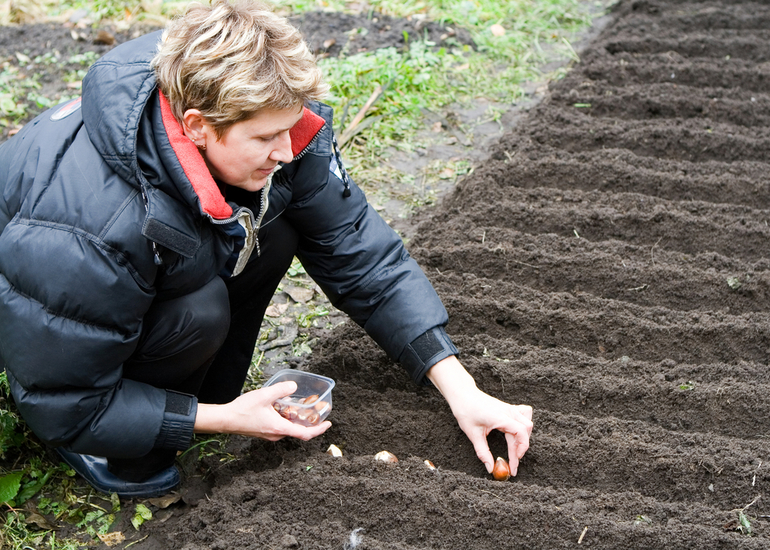
You can understand when to plant tulips in the fall (in which months and place) by their developmental features: for rapid growth, they need coolness. In cool autumn time, growth processes are activated in them, roots are formed, and the plant itself is actively stocked with nutrition. With the onset of spring, flowers quickly grow, the plant develops well, which affects the buds.
Spring planting is less profitable. The absence of a “cold” period affects badly the appearance of plants (they grow thinner and weaker) and the quality of future bulbs.
It is best to land in mid-September to late November, depending on the specific region and climate. Planting too early (in late summer or early autumn) leads to germination of bulbs, freezing of sprouts and rotting of flowers, too late - to freezing of bulbs and inability to root.
When choosing a time when to plant tulips in the winter, pay attention to the following points:
- Region. In the north (in Siberia and the Northern Urals) it is better to plant tulips in the first half of autumn, in the more southern regions of the Russian Federation and Ukraine - in the second. For central Russia, it is better to carry out work until the end of October.
- The weather. Long rains or early frosts can ruin the bulbs even before they are rooted.
- The proximity of frost. Before freezing the ground and the onset of severe cold should remain about 7-8 weeks.
- Air temperature. It should be approximately + 3-5 degrees.
- Earth temperature. At a depth of 10 cm, it should not be higher than + 8−10 degrees.
Place requirements
It is equally important to choose a good place to land. It is necessary not only to arrange a beautiful and comfortable gardener bed, but also to choose good land and a plot suitable for flowers.
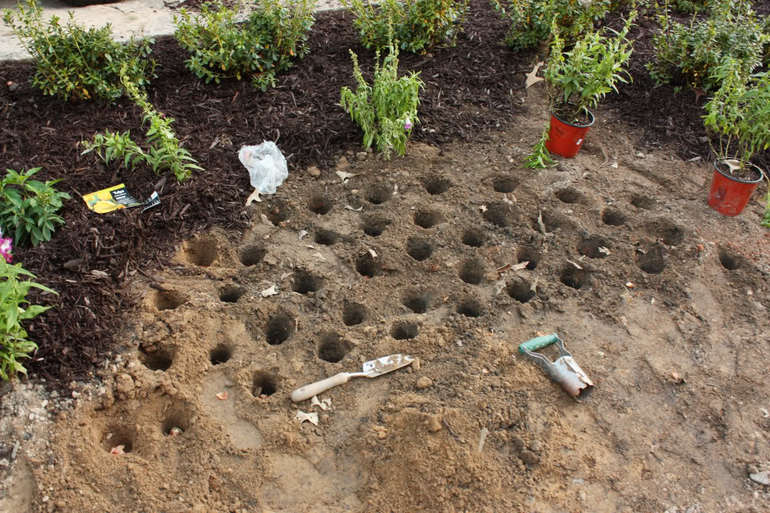
When choosing the following points should be noted:
- You need to choose a sunny, well-lit area, protected from the wind.
- It is advisable to plant tulips on a hill or on a slope so that excess water drains. Lowlands or excessively moist soils are not suitable, as the bulbs will begin to rot. In the latter case, it is worth equipping high beds.
- The earth should be loose, with good drainage, slightly alkaline or neutral. Acidic soil does not fit.
- Sandy and loamy soils are well suited. If the earth is clayey, too heavy, it can be improved by adding peat or river sand (5 kg per 1 sq. M), if sandy, clay crumb is introduced (about a bucket per 1 sq. M).
- You should not plant tulips in the beds on which cucumbers, zucchini, melons, tomatoes, watermelons or asters had grown before.
Soil preparation
Making a garden and planting bulbs in the ground is not enough. It is necessary to prepare the soil and, if necessary, improve it, so that the bulbs can grow faster and take root.
Preparation consists of several steps.:
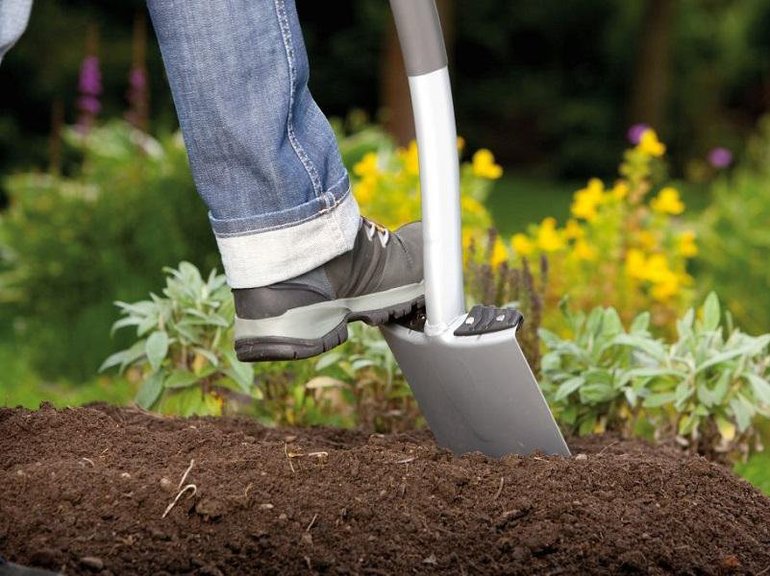
- A month before the date of planting, you must carefully dig the site, going to a depth of 25-30 cm, and clean it of roots and weeds. Such advance preparation is needed for the soil to settle: too loose soil can damage weak roots.
- Then apply special fertilizers for the bulbs or prepared independently. The latter consists of 5 kg of compost (or rotted humus), 200 grams of wood ash, 50 grams of superphosphate and 15 grams of ammonia acid. This amount is paid per 1 square. m of land.
- If necessary, clay or sand is added to improve the soil itself.
- 2 days before planting, the ground is watered with water for its full shrinkage.
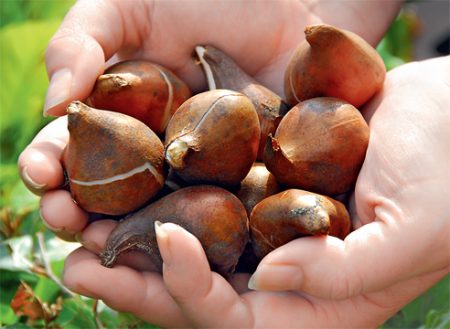 You may be interested in:
You may be interested in:Seed Check
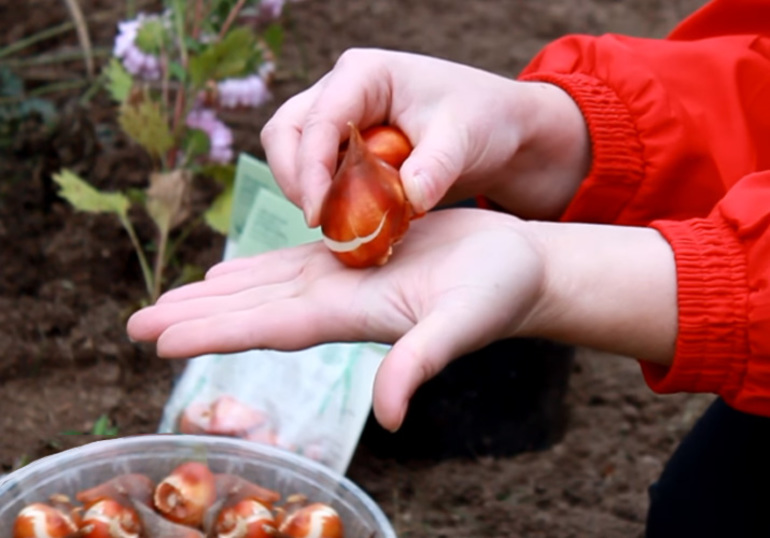
Planting tulips in the fall in the Leningrad region and other regions begins with the inspection and rejection of planting material. Rotten, dry or damaged bulbs with mold, stains or cracks are best discarded. It is desirable that the diameter of the selected material be approximately 3-4 cm.
The brown shell must be intact, the bud of the stem is noticeable, but not sprouted, the bottom of the bulb is dense, with tubercles of roots. If the bottom is soft or roots appear, the bulb is not suitable for planting.
Just before planting, it is worth sorting the seed by size and planting in groups. In this case, larger flowers will not be able to “clog” the weak.
Main works
Soil prepared in advance does not require any additional tricks. However, the gardener should calculate in advance exactly how he will arrange the flowers. They can be planted in separate holes or furrows. The first option is beneficial if there are few tulips, they are of different sizes, or you want to plant them between already growing flowers. Furrows (or longitudinal rows) allow you to land a large amount of material, folding the pattern.
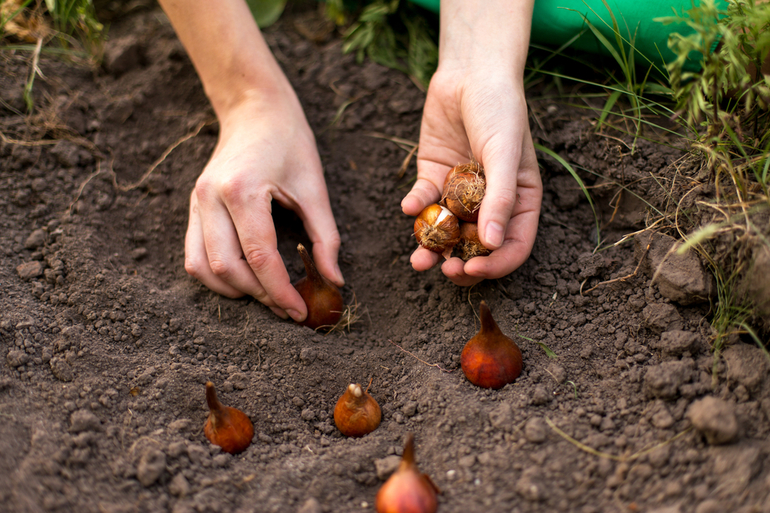
Landing is a few steps:
- First, deepenings are made in the ground - pits or rows. Their depth depends on the size of the bulbs themselves and can range from 5 to 15 cm. When choosing which depth to plant tulips in the fall and, accordingly, dig holes, it is better to use the formula: depth = 3 * (bulb height). For example, for a bulb 3 cm high, the depth is 9-10 cm.
- The distance between the bulbs should be 8-15 cm. The exact figure depends on the goal: to create a lush garden or fill the pattern, it can be 8-10 cm, but it is better to keep a greater distance - 10-15 cm.
- The distance between the rows should be at least 25-30 cm.
- To improve the land and its drainage properties, a layer of river sand (1−2 cm) can be poured onto the bottom of the pit, “covered” with a layer of soil from above.
- To protect against mice, the bottom of the bulb should be greased with birch tar or Vishnevsky ointment.
- Bulbs are planted upside down or sideways, squeezing slightly so that they slightly go into the ground, but do not damage the roots. This is required to eliminate air under the bottom.
- Wells are filled with soil and leveled. If you leave the tulips open, water will begin to accumulate in the cavity, which will lead to decay.
- In dry and warm weather, after a few days, it is advisable to water the garden bed so that the roots form correctly.
Flowers will not require any more care. They do not need to be covered with something after landing, otherwise they will quickly grow and rise just in time for the cold. Exception: sharp cold, which can destroy weak, not yet rooted bulbs.
It is important to note that varietal tulips are more moody and yet require some additional care. They need to be fertilized 2-3 times per season, choosing mineral fertilizers. This must be done before the snow melts (scattering dry fertilizer in the snow), after emergence and after flowering.
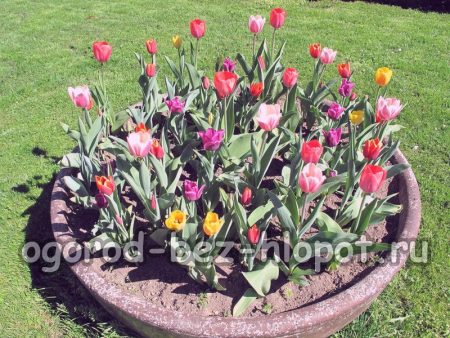 You may be interested in:
You may be interested in:Unexpected situations
It happens that the weather deteriorates too sharply or the gardeners themselves do not have time to plant the seed. In such situations, many abandon plans for planting flowers or risk planting them in the spring.
But sometimes the situation can be fixed otherwise:
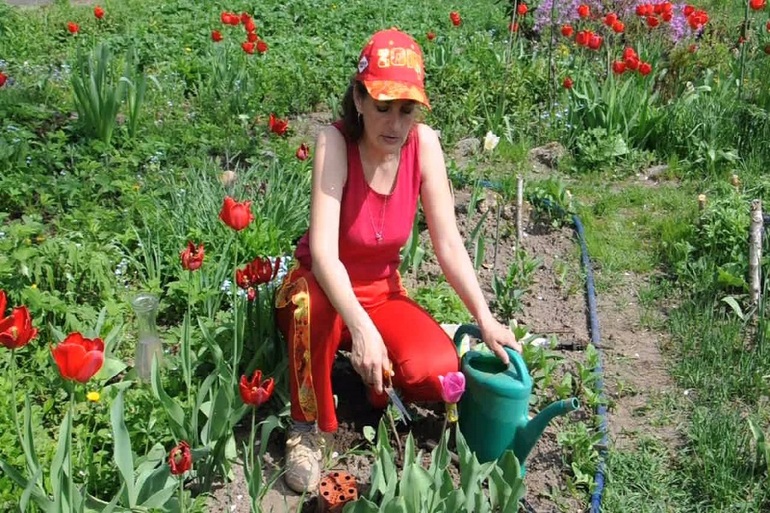
- If the planting dates are running out, but the ground is still cold, you can plant flowers and cover them with spruce branches, compost or dry leaves on top for protection. With little snow, you will need to additionally cover them with snow.
- The second option is to plant the seed in separate containers at the cottage. Rooted plants are stored until spring in a cool place (in the basement or on the balcony), after which they are planted in the ground in spring. Pour a layer of drainage material (at least 5 cm) into the container itself, pour earth on top, plant the bulbs, pour and leave it warm (at room temperature) for 3 weeks to root. Then the container is cleaned in cool.
- Some gardeners prefer to plant bulbs in special baskets for bulb flowers. Unlike conventional solid containers, they are containers with openings. In spring, you can bury the baskets themselves in the ground, not digging up tulips. Thanks to the holes in the bottom and walls, the flowers will be able to fully eat. This method is also suitable if the plot is completely unsuitable soil: it is enough to fill the basket with chernozem without filling the entire bed.
- If tulips have already begun to grow, it is better to plant them as house plants.
- If sick bulbs do not want to be thrown away, you can carefully remove the problem areas with a sharp knife, grease the cut with green leaf and plant them separately. You can not plant sick and healthy specimens nearby, since the infection will spread to everyone.
Bright, eye-catching tulips are not without reason considered to be one of the main spring flowers. They appear among the first and adorn the "bare" bed almost the entire spring. Another plus is the unpretentiousness of colors: planting bulbs in the fall immediately in the open ground, you can get a beautiful flowerbed in spring.

 When and how to plant tulips in autumn in the open ground
When and how to plant tulips in autumn in the open ground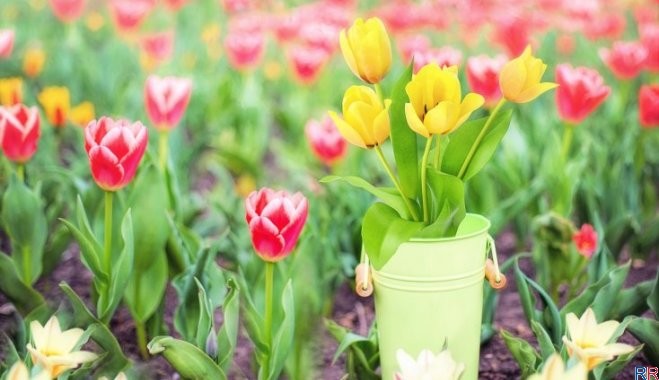 When to dig out tulips after flowering and when to plant again in the ground
When to dig out tulips after flowering and when to plant again in the ground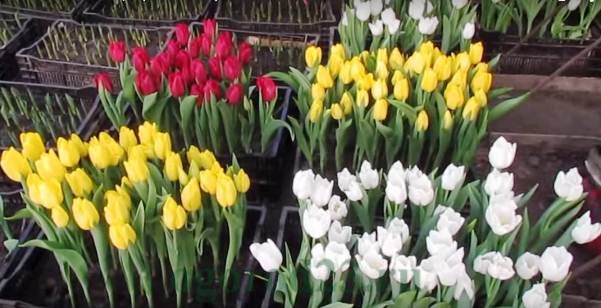 We plant tulips at home on March 8
We plant tulips at home on March 8 How to save tulip bulbs after flowering until next spring
How to save tulip bulbs after flowering until next spring